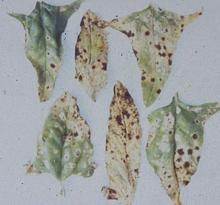By L.J. du Toit and C.M. Ocamb
See:
Spinach (Spinacia oleracea) - Stemphylium Leaf Spot
Cause A complex of fungi is associated with leaf spot disease on spinach, but Cladosporium variable is believed to be the primary pathogen under cool and moist conditions. This fungus can grow under a wide range of temperatures, but 59°F to 68°F with relative humidity above 80% is most conducive to disease development. Spores can be moved by air, rain or irrigation splash, or equipment. Volunteer spinach can serve as a reservoir, particularly following spinach seed crops when many volunteers may develop in the field over the winter from seed that shattered to the ground during seed harvest. Some semisavoy types like 'Ozarka II' and 'Fall Green' have been shown highly susceptible in greenhouse tests and field observations.
Symptoms Early symptoms are numerous small, circular white to yellow spots, beginning on older leaves and progressing to younger ones. Spots often join together and then are irregularly shaped. Older spots develop a narrow darker-colored margin with a tan center. When the fungus produces spores, spots change to an olive-black. Generally, older leaves die, but in severe infections all leaves may die and seed may be affected. Ripening seed on spinach seed crops also may develop lesions, shrivel, and become infected with the fungus.
Cultural control
- Disc volunteer plants into the ground before planting spring crops.
- Avoid highly susceptible plant types.
- Hot water treatment of spinach seed at 104°F to 122°F for 10 to 20 min. can be very effective. Seed must be dried well after treatment to avoid reduction in shelf life.
Chemical control Fungicides used preventively help minimize the onset of infection and disease development.
- Bravo Weather Stik (Group M5) at 3 pints/A on 7- to 14-day intervals; begin applications just prior to pollen shed. For spinach seed crops in Oregon only (SLN OR-200014) and Washington only (SLN WA-190001). 12-hr reentry.
- Mancozeb formulations (Group M3) are labeled.
- Dithane F45 Rainshield at 1.5 quart/A on 7- to 10-day intervals can be used on seed crops only. Washington and Oregon only (SLN WA-220008, SLN OR-240011). 24-hr reentry.
- Roper DF Rainshield at 2 lb/A on 7- to 10-day intervals can be used on seed crops only. Washington only (SLN WA-1300003). 24-hr reentry.
- Trilogy at 0.5% to 1%. Not labeled for use in Oregon. Do not use above 90°F or when plants are under heat or moisture stress. Do not use when foliage is wet as good coverage is essential. Poor control as a stand-alone product. 4-hr reentry. O
Biological control
- Double Nickel LC at 1 to 6 quarts/A on 3- to 10-day intervals. Can be applied the day of harvest. 4-hr reentry. O
- LifeGard WG at 1 to 4.5 oz/A on 7- to 14-day intervals for activating plant resistance. Refer to label for appropriate rate per application volume. Preharvest interval is 0 days. 4-hr reentry. O
References du Toit, L.J., Derie, M.L., and Hernandez-Perez, P. 2005. Evaluation of fungicides for control of leaf spot in spinach seed crops, 2004. Fungicide & Nematicide Tests 60:V044.
du Toit, L.J., and Hernandez-Perez, P. 2005. Efficacy of hot water and chlorine for eradication of Cladosporium variabile, Stemphylium botryosum, and Verticillium dahliae from spinach seed. Plant Disease 89:1305-1312.



